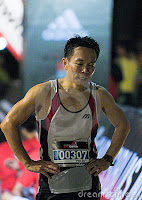To make pancakes into a balanced sports meal, enjoy them with a poached egg or a tub of Greek yogurt (for a protein boost) plus some fruit salad or glass of juice.
Here’s a recipe for light and fluffy prizewinners.
Oatmeal Pancakes
1/2 cup uncooked oats (quick or old fashioned)
1/2 cup plain yogurt, buttermilk (or milk mixed with 1/2 tsp vinegar)
1/2 to 3/4 cup milk
1 egg or 2 egg whites, beaten
1 tablespoon oil, preferably canola
2 tablespoons packed brown sugar
1/2 teaspoon salt, as desired
1 teaspoon baking powder
1 cup flour, preferably half whole-wheat and half white
Optional: dash cinnamon
1. In a medium bowl, combine the oats, yogurt, and milk. Set aside for 15 to 20 minutes to let the oatmeal soften.
2. When the oatmeal is through soaking, beat in the egg and oil and mix well. Add the sugar, salt (and cinnamon). Stir the baking powder into the flour; then add and stir until just moistened. For best results, let the batter stand for 5 minutes before cooking.
3. Heat a lightly oiled or nonstick griddle over medium-high heat.
4. For each pancake, pour about 1/4 cup batter onto the griddle. Turn when the tops are covered with bubbles and the edges look cooked. Turn only once.
5. Serve with syrup, honey, applesauce, yogurt, or other topping of your choice.
Yield: six 6-inch pancakes Total calories: 1,000
Calories/serving (2 pancakes): 330 57 g Carb; 10 g Pro; 7 g Fat
This is just one of many recipes in Nancy Clark’s Sports Nutrition Guidebook, 4th Edition
Manya Makoski’s Snickerdoodle Pancakes
This recipe is from soccer pro Manya Makoski. Manya’s addition of yogurt and strawberries makes this a complete and healthful meal.
2 eggs
¼ cup (35 g) sugar
2 teaspoons (10 g) baking powder
1/4 teaspoon (1 g) salt
2 teaspoons (10 g) vanilla extract
2 teaspoons (2 g) ground cinnamon
2 cups (250 g)flour (preferably half whole wheat)
1/2 cup (120 ml) milk
1. Beat eggs and sugar together with a whisk.
2. Add in the baking powder, salt, vanilla, and cinnamon. Stir in the flour and milk until the batter is mixed well.
3. Heat the frying pan and spray with non-stick cooking spray. Pour batter into small circles on the frying pan. Flip when small bubbles reach the surface of the batter and the edges of the pancakes are dry.
4. Enjoy with vanilla yogurt and strawberries.
Yield: 4 servings
Total Calories: 1,200 (without toppings)
Calories per serving: 300
60 g Carbohydrate
9 g Protein
3 g Fat
From: Food Guide for Soccer: Tips and Recipes from the Pros by Nancy Clark and Gloria Averbuch.






